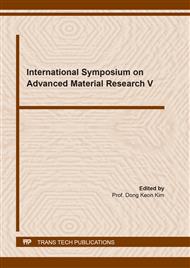p.17
p.25
p.35
p.43
p.53
p.63
p.71
p.79
p.87
Gravimetric and Statistical Data Analysis of the Protection Performance of Aloe vulgaris and Nicotiana tabacum Leaf Extracts on 1070 Aluminum and Mild Steel
Abstract:
The protection performance Aloe vulgaris (AV) and Nicotiana tabacum (NT) leaf extracts on 1070 aluminum (Al) were separately studied while the combined admixture of the extracts (AVNT) on mild steel (MS) was also studied in 3.5% NaCl solution by gravimetric analysis. Data output showed AV and NT effectively stifled the redox reaction process responsible for Al corrosion in NaCl with protection performance data above 98% throughout the exposure hours signifying strong resilience of the extract molecules withstanding the corrosive anions and thermodynamic stability with respect to exposure time. AVNT performed effective on mild steel at relatively lower efficiency, but with final values above 80% efficiency. Statistical data for standard deviation shows the degree of variation of protection performance data for AV, NT and AVNT extracts from mean value is minimal signifying consistent data value with respect to exposure time. Data also showed 100% of AV and NT protection performance data are above 98% efficiency value at +0% margin of error while 14.29% of AVNT protection performance data are above 95% efficiency at margin of error of +14.97%. Data from analysis of variance shows AV extract concentration and observation time strongly influences the performance out of AV at rated value of 42.06% and 29.41%. NT extract concentration solely dominated the performance output of NT at 95.37% while the performance of AVNT was independent of its concentration with values below threshold significance. However, AVNT performance varied significantly with observation time signifying progressive improvement in performance in over time.
Info:
Periodical:
Pages:
53-60
Citation:
Online since:
March 2022
Authors:
Keywords:
Price:
Сopyright:
© 2022 Trans Tech Publications Ltd. All Rights Reserved
Share:
Citation:


